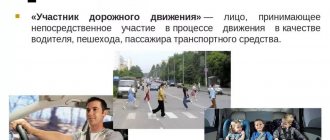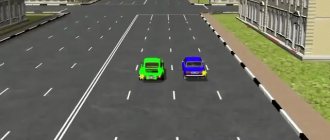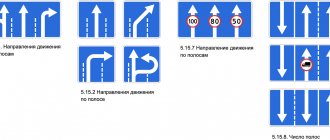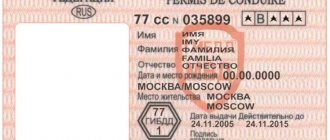What does the traffic rules say?
The traffic rules do not provide a clear definition of the concept of maneuver. However, there is a whole section (number called “Starting movement, maneuvering.” It presents examples of maneuvers and also describes the requirements for their implementation.
However, there is a whole section (number called “Starting movement, maneuvering.” It presents examples of maneuvers and also describes the requirements for their implementation.
What specifically refers to maneuvers
A maneuver is any action that is aimed at changing the trajectory of a vehicle relative to the road along which it is moving. This concept is present in the text of paragraph 1.2 of the Russian Traffic Regulations. Maneuvering rules are discussed in more detail in Section 8.
Maneuvers include:
- start of movement;
- turn;
- turn;
- changing lanes;
- detour and overtaking;
- stop;
- driving the vehicle in reverse;
- access to the sidewalk and exit to the side of the road.
The maneuver does not involve driving around a roundabout.
Maneuvering - Traffic rules establish strict standards of behavior
The collection of traffic rules has a separate large chapter devoted to maneuvering, but administrative language does not always contribute to memorization and assimilation, so we will talk about this in a more free form and, so to speak, from the everyday side of the issue. Let's start with the main thing. This is a designation for maneuvering. The rules strongly recommend that you always indicate your intentions clearly, precisely and in a timely manner . For this purpose, the car has special lights at the front and rear. If they don't work, you can do it by hand through the open side window.
The basic pattern of giving signs is that this must be done immediately before the maneuver, but not at the moment of its implementation. It is difficult to name a time interval, since it does not exist, sometimes the driving culture welcomes early signals so that those behind can change lanes and not break their pace, and sometimes signals turned on too early can mislead them. For example, you want to turn left and showed the signal too early, and there are at least three left turns in front of you, but you did not attach any importance to this. But the driver behind you will not know whether he is on the way with you or you are turning earlier, you need to change lanes and overtake, or it is more practical to wait until you turn, etc.
In addition, in no case does a timely signal give you an advantage in traffic, so when maneuvering you should respect not only the calmness of neighboring drivers, but also the principle of accident-free traffic in general. When changing lanes, you are like a guest on a new lane and road, which means you must respect the order that has already developed there. The advice of every experienced motorist is to make as few movements as possible on the road, because today the density of cars in cities, especially large ones, is so high. Therefore, think over your trajectory much in advance in order to be less likely to disturb other road users in an emergency.
Turns, U-turns and lane changes correspond to the turn indicator on the side of the car in which direction you intend to make the maneuver. When stopping, the turn signal is in the direction where you plan to lean the tired body of the car (for example, the side of the road/curb), and when starting off, in the opposite direction from the curb. Hand signals: stop - straight arm up, direction of maneuver - straight arm in the direction of the maneuver or bent arm at the elbow opposite to the maneuver.
Article on the topic: I bought a Ford and received a rifle as a gift!
Standards of driver behavior when maneuvering
The driver is required to warn other motorists, motorcyclists and pedestrians that he is about to perform a maneuver. Paragraph 8.1 of the traffic rules lists maneuvers during which the turn signal must be turned on.
- Turn and turn.
- Changing lanes (including overtaking and advancing).
- Start of movement from the curb or sidewalk.
- Drive to the edge of the roadway (side) and stop.
If the turn signals do not work for some reason, the driver must signal a turn with his hand.
The driver, before starting the maneuver, must ensure that:
- it will not interfere with other road users and will not force them to change their driving trajectory;
- the turn signal is in good working order and can be seen by other drivers and pedestrians;
- the action is not prohibited on this section of the roadway.
You should always remember that the given light signal is only informative and does not provide any advantage. The turn signal must stop immediately after completing the maneuver.
You should not make excessive maneuvers unnecessarily, for example, frequently change lanes from one lane to another. Such car enthusiasts are called checkers players. They do not want to move in the general flow of cars and always strive to change lanes in order to get ahead or overtake someone. It is better to avoid such motorists, because they are likely to cause an accident.
In addition, such behavior suggests that the driver is in a state of irritation or tension, which prevents adequate behavior on the road.
Advancing and overtaking must not be prevented. There are often motorists who try to compete when they see that they want to get ahead of them. It is important to remember that the track is not a place for racing or settling disputes. If you come across a driver on the way who wants to arrange a competition, then you should let him pass without succumbing to provocation.
Traffic rules tips: starting to move, maneuvering to the sides
We have learned the main rules of tact and safety, now let’s talk about other nuances. For example, you must yield not only to cars when making a maneuver, but also to pedestrians, horse riders, cyclists and other participants if you cross their path, and they are allowed to move at that moment. For example, you turned right, and there is a pedestrian crossing with a green traffic light, you will have to wait until people finish their movement.
As already mentioned, in the traffic rules the beginning of movement is maneuvering, which means that everything described above also applies to this situation. You must give in to everyone, because at an unfavorable speed you are merging into the flow, which can cause unnecessary braking of other drivers, their angry exclamations and indignant signals. Changing lanes at an intersection can cause the same reaction; even the markings prohibit this; these are places of particular danger, so unnecessary movements there are doubly undesirable. The exception is roundabouts, where you can change lanes.
The golden rule “interference on the right” is well known to many, but rarely does anyone remember it while driving, hence many unexpected accidents. You may not be the only one involved in changing lanes or turning, so watch the right wing of the car and the roadway on its side, they can also maneuver from there, and you must yield to that participant. And in general, if you pay attention to the text of the traffic rules, there are repeated hints that you can’t just drift along the lanes, especially if they are all evenly occupied by traffic.
Article on the topic: Expansion tank VAZ 2110 and 2114 - replacement or repair?
Where and what types of maneuvers can be performed
You should be careful about the prohibitions on performing a particular maneuver on a certain section of the road. For example, turning around and moving backwards are prohibited:
- In the tunnels.
- At pedestrian crossings.
- At railway crossings.
- If there is a marking 1.18, which prohibits turning left.
- On bridges, overpasses, guideways, and also under them.
- When visibility is poor, less than 100 meters in one direction, including in places with steep slopes that limit visibility.
- At stops designated for public transport.
- Reversing is prohibited on motorways.
- If there are road signs prohibiting U-turns and left turns.
If, when turning right or changing lanes to the right, another car turns left (changes lanes) at the same time, then you should follow the right-hand rule, that is, let it pass. All turns are made in such a way that the vehicle does not end up in the lane of oncoming traffic and does not create an obstacle.
It is undesirable to occupy tram tracks, since “the tram is always right” and motorists have no right to interfere with it. You can drive onto tram tracks only in special cases, for example, when turning left, taking into account the absence of a turn lane and corresponding signs.
Traffic regulations | 8. Start of movement, maneuvering
Home / Traffic rules of the Russian Federation / Section 8.
Traffic regulations SignsMarking Vehicle approval
Traffic rules:
8.1. Before starting to move, change lanes, turn (U-turn) and stop, the driver is required to give signals with turn signals in the appropriate direction, and if they are missing or faulty, with his hand. When performing a maneuver, there should be no danger to traffic or interference with other road users.
The signal for a left turn (turn) corresponds to the left arm extended to the side or the right arm extended to the side and bent at the elbow at a right angle upward.
The right turn signal corresponds to the right arm extended to the side or the left arm extended to the side and bent at the elbow at a right angle upward.
The brake signal is given by raising your left or right hand.
8.2. The turn signal or hand signal must be given well in advance of the maneuver and cease immediately after completion (the hand signal may be terminated immediately before the maneuver). In this case, the signal should not mislead other road users.
Signaling does not give the driver an advantage or relieve him from taking precautions.
8.3. When entering the road from the adjacent territory, the driver must give way to vehicles and pedestrians moving along it, and when leaving the road - to pedestrians and cyclists whose movement path he crosses.
8.4. When changing lanes, the driver must give way to vehicles moving in the same direction without changing direction. When simultaneously changing lanes of vehicles moving in the same direction, the driver must give way to the vehicle on the right.
8.5. Before turning right, left or making a U-turn, the driver is obliged to take in advance the appropriate extreme position on the roadway intended for traffic in this direction, except in cases where a turn is made when entering an intersection where a roundabout is organized.
If there are tram tracks in the same direction on the left, located at the same level as the roadway, a left turn and a U-turn must be made from them, unless signs 5.15.1 or 5.15.2 or markings 1.18 prescribe a different movement order. In this case, there should be no interference with the tram.
8.6. The turn must be carried out in such a way that when leaving the intersection of roadways the vehicle does not end up on the side of oncoming traffic.
When turning right, the vehicle should move as close as possible to the right edge of the roadway.
8.7. If a vehicle, due to its size or for other reasons, cannot make a turn in compliance with the requirements of paragraph 8.5 of the Rules, it is allowed to retreat from them provided that traffic safety is ensured and if this does not interfere with other vehicles.
8.8. When turning left or making a U-turn outside an intersection, the driver of a trackless vehicle must give way to oncoming vehicles and a tram in the same direction.
If, when turning outside an intersection, the width of the roadway is not sufficient to perform the maneuver from the extreme left position, it is allowed to be made from the right edge of the roadway (from the right shoulder). In this case, the driver must give way to passing and oncoming vehicles.
8.9. In cases where the trajectories of vehicles intersect, and the order of passage is not specified by the Rules, the driver to whom the vehicle is approaching from the right must give way.
8.10. If there is a braking lane, the driver intending to turn must change lanes in a timely manner and reduce speed only in this lane.
If there is an acceleration lane at the entrance to the road, the driver must move along it and change lanes into the adjacent lane, giving way to vehicles moving along this road.
8.11. U-turn is prohibited:
- at pedestrian crossings;
- in tunnels;
- on bridges, overpasses, overpasses and under them;
- at railway crossings;
- in places where visibility of the road in at least one direction is less than 100 m;
- in places where route vehicles stop.
8.12. Reversing a vehicle is permitted provided that this maneuver is safe and does not interfere with other road users. If necessary, the driver must seek the help of others.
Reversing is prohibited at intersections and in places where turning around is prohibited in accordance with paragraph 8.11 of the Rules.
Comments (9)
| Glad Valakas 07/08/2019 at 04:37 pm Yyyyyyyyyy [Reply] [Cancel reply] | +9 |
| Vitaly 01/16/2018 at 14:03 Is reversing on a one-way road prohibited? [Reply] [Cancel reply] | 0 |
| Mikhail 07/01/2020 at 12:45 Actually, that’s a good question... When I studied in 2003, it was prohibited. And now it’s allowed. It’s the same with overtaking at uncontrolled intersections on the main road. And how does this correspond to traffic safety?.. I'm amazed [Reply] [Cancel reply] | 0 |
| Andrey 09/11/2018 at 21:53 Actually, it’s prohibited! They say “one-way traffic”. If you move against the flow, no matter backwards or forwards, this is a violation. As a rule, on the other side they hang a “brick” sign among the common people. For driving under it, deprivation of rights. And it doesn’t matter front or back... [Reply] [Cancel reply] | -17 |
| Grandfather 08/09/2019 at 23:25 Reversing on a one-way road is allowed! what brick, hello?! [Reply] [Cancel reply] | +12 |
| Vladimir 02/09/2019 at 12:02 And where is it said about one-way traffic? [Reply] [Cancel reply] | 0 |
| Dmitry 12/12/2018 at 12:50 Actually, you need to learn the rules. [Reply] [Cancel reply] | -1 |
| Sophia 01/24/2018 at 11:34 pm Not prohibited. The main thing is not to interfere and remember 8.11 [Reply] [Cancel reply] | +18 |
| Anna 08/28/2017 at 06:03 pm class [Reply] [Cancel reply] | +3 |
coming
News
03/26/2021 Changes in the practical part of the traffic rules exam from April 1, 2021
03/01/2021 New sign 6.22 “Photo and video recording” in traffic rules
All news
What road signs should you pay attention to?
You need to make sure that there are no signs that prohibit this or that action.
- turning right is prohibited at signs 3.18.1, 4.1.1, 4.1.3, 4.1.5, 5.7.2, 5.13.2, as well as signs 3.2 or 3.3 with a sign 8.3.1.;
- turning left and turning around are not allowed with signs 3.18.2, 4.1.1, 4.1.2, 4.1.4, 5.7.1, 5.13.1, 6.3.1, 6.3.2, as well as signs 3.2 or 3.3 with a sign 8.3.2 , as well as 5.15.1 or 5.15.2, on which there is no left turn arrow, or markings corresponding to these signs 1.18.;
- overtaking is not allowed where sign 3.20 is installed.
Dangerous moments during maneuvers
Maneuvering always carries danger, mostly resulting from driver inattention and miscommunication. To avoid a collision, you should always warn about your further actions in advance.
Likewise, you need to keep an eye on what other motorists are going to do. You should always keep your distance from other cars so that you don’t drive into a vehicle during sudden or emergency braking.
The danger when driving backwards is that blind spots may occur. In this case, you need to resort to the help of third parties, that is, ask a person to orient you from the street. In any case, such a maneuver requires caution and slowness. It’s better to get out of the car and look around once again than to repair the car.
Special cases
If there are many lanes on the road, then maneuvers are carried out as follows:
| Did not find an answer to your question? Call a lawyer! Moscow: +7 (499) 110-89-42 St. Petersburg: +7 (812) 385-56-34 Russia: +7 (499) 755-96-84 |
- Turn right - from the far right lane to the far right lane of the cross road.
- Turn left and make a U-turn - from the leftmost lane to any lane intended for traffic in a given direction (not to the oncoming lane).
Special cases include meeting vehicles with flashing lights and a sound signal turned on. If such a car is driving, then you should let it pass, and perform the maneuver only if it does not interfere with the passage of the vehicle.










